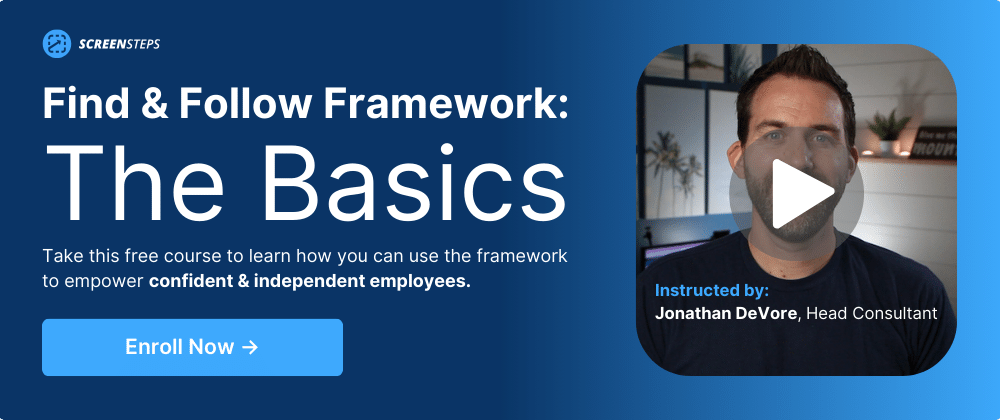How to Train Gen Z Employees in the Workplace (7 Best Practices)
What is the best way to train Gen Z employees?
The short answer is to meet them where they are at. The long answer (or a more detailed answer) is this blog post.
Working for ScreenSteps — a knowledge ops solution that helps companies transfer knowledge more efficiently — I’ve learned best practices for training employees. And after researching Gen Z traits, I better understand how Gen Z learns. From that research, I’ve developed this list.
Discover seven best practices you can incorporate into your employee training curriculum for training Gen Z employees.
1. Train to their strengths
Gen Z is the Google generation, meaning they grew up having access to answers at their fingertips. This generation expects to have that same access in their companies — but they don’t always have that resource.
 They are accustomed to turning to a search bar when they have a question. According to a study by YPulse, 18- to 24-year-olds start their search on:
They are accustomed to turning to a search bar when they have a question. According to a study by YPulse, 18- to 24-year-olds start their search on:
- 46% with Google
- 21% with TikTok
- 5% with YouTube
They naturally lean on technology for support. You can look at this or a negative OR you could leverage this skill.
Build your staff an internal Google. That means building a knowledge base, knowledge ops platform, or other centralized hub with advanced search capabilities.
During training, you teach your employees how to use your internal Google to find answers and learn how to handle procedures.
This teaching technique will empower your Gen Z employees during onboarding and with continuous learning as they rely on your system for answers.
2. Provide visual examples
In your training materials, ditch the text-heavy slides. Instead, focus on providing more images that illustrate what they are learning.
Your images don’t have to be the product or concept. The images can relate to an analogy you share to teach the concept. Those analogies and images will help learners connect the dots.
3. Provide hands-on experience
If you want your Gen Z employees to increase in confidence and independence, you’ll want to spend most of your training time on hands-on experience.
Immersive learning experiences are valuable. When new hires role-play real-job scenarios, it helps them realize that they can do it.
Plus, this gives Gen Z employees more time to collaborate with other employees from the beginning. Gen Z values collaboration and teamwork.
Role-playing allows your new hires to learn and correct one another, working as a team to learn your policies and procedures.
4. Use self-paced courses
Gen Z likes flexibility and autonomy in learning. Offer them flexibility in learning with self-paced courses.
These self-paced courses can be video courses or text-based courses. They could include gamification or not. The purpose is that employees can take them on their own time during the workday.
Some software options you can leverage to create these courses are a learning management system (LMS) or a knowledge ops platform.
If you create video courses, keep in mind the “snack-size” or “bite-size” videos, which leads me to the next best practice.
5. Watch your pacing
Give bite-sized learning segments. Traditional training methods often involve long hours of sitting in a classroom and listening to a PowerPoint lecture. That doesn’t work for Gen Z.
This generation is used to bite-sized segments. They consume TikTok videos (up to 3 minutes long), Instagram reels (90 seconds max), and YouTube Shorts (60 seconds max).

Break up your training. Now, I know 60 seconds is probably impossible to teach a concept, but 10-20 minutes of lectured learning (i.e. foundational courses) that mixes with a role-playing activity is realistic.
Your training pacing should keep learning moving along steadily.
6. Include gamification
For a generation that relies on technology and is used to being entertained, gamification can make training more exciting.
Gamification is a fun, interactive way for new hires to review what they learn.
Look no further than DuoLingo for how engaging gamification can be. The language learning application has made it fun by competing for the longest “streak,” or the number of days in a row that a learner completes a lesson. (Plus, its mascot’s social media presence has made it a pop culture phenomenon.)
Some examples of gamification for workplace learning include rewards, leaderboards, interactive games (Like identifying the objects in an image), etc.
7. Leverage technology
Technology is practically an extension of Gen Z. This generation grew up in a world where businesses regularly released new applications and technologies.
While I’ve mentioned a few software options to support your training, here is a bulleted list of technology you can leverage for training:
Develop a training strategy that speaks to Gen Z’s strengths
Gen Z has the potential to be some of your greatest employees. The key is to figure out how to unlock that potential.
To empower your Gen Z employees, you need the right training curriculum. Your training strategy should follow the pattern of how Gen Z naturally learns.
The Find & Follow Framework is a knowledge transfer strategy that matches Gen Z’s strengths. With Find & Follow Training, you create an internal Google and have employees learn how to self-service answers with your systems.
Gen Z employees learn faster and are more efficient when you use the Find & Follow Framework.
How does the Find & Follow Framework work?
Take the free 30-minute course for an overview of the framework. Or, if you’re more of a reader, you can download the free Find & Follow Framework playbook here.




